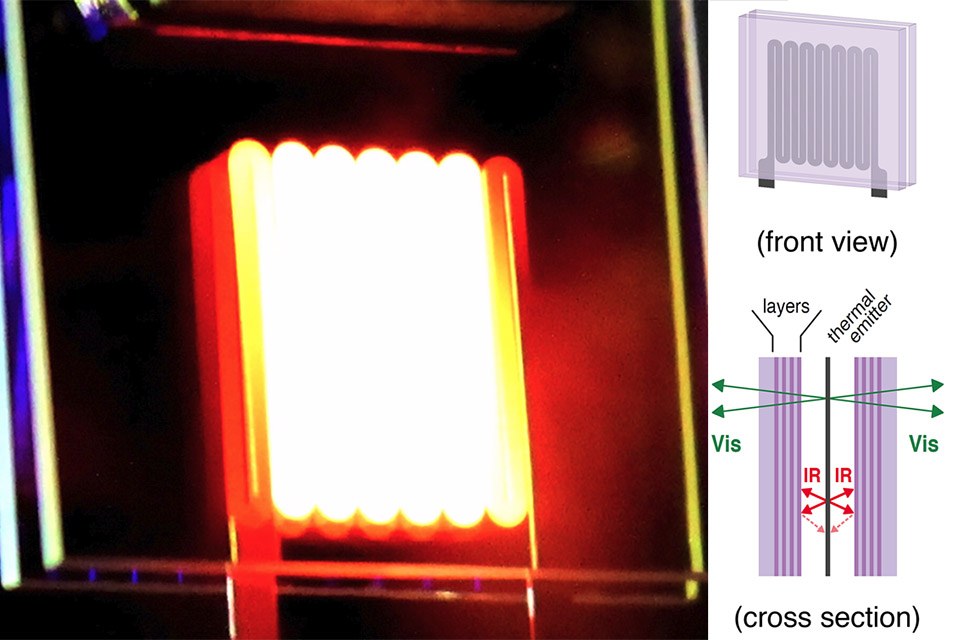Innovation Could Revive Incandescent Lighting, Bring More Efficient Solar Cells
Incandescent lighting could make a comeback with a new type of filter that "recycles" infrared photons and improves efficiency, an innovation that also could enable solar cells to convert heat into electricity more efficiently than conventional photovoltaic technology.
"The biggest disadvantage of incandescent lighting has been a lack of energy efficiency,” said Peter Bermel, an assistant professor in Purdue University's School of Electrical and Computer Engineering. "The way incandescent lights work is that you heat a filament to a certain temperature and it emits a broad band of light, but only about one in 20 photons or so is actually visible to the human eye; the other 19 photons are essentially just wasted as heat."
Now researchers have developed a potential solution: a new type of filter to recycle wasted photons that is made out of alternating layers of materials such as silicon dioxide and tantalum dioxide, each with thicknesses less than 1/100th that of a human hair. This approach could improve incandescent lighting efficiency by 10 times, making it more efficient than commercial compact fluorescent and LED lighting, said Bermel, who worked with researchers at the Massachusetts Institute of Technology to develop the filter.
The efficiency of the new lighting source already approaches that of some fluorescent and LED bulbs, and could approach 40 percent, surpassing all existing energy-efficient lighting sources. Commercially available fluorescent lighting has an efficiency range from 7 percent to 13 percent and LED lighting products range from 5 percent to 13 percent, while more advanced LED lamps under development may range as high as 29 percent.
The Nature Nanotechnology paper was authored by MIT postdoctoral associate Ognjen Ilic; Bermel; and also from MIT: Gang Chen, head of the Department of Mechanical Engineering and Carl Richard Soderberg Professor of Power Engineering; John D. Joannopoulos, the Francis Wright Davis Professor of Physics; principal research scientist Ivan Celanovic; and Marin Soljačić, a professor of physics.
Bermel filament
The selective filter designed and built by the researchers allows the passage of visible photons but not infrared photons, which reflect back to the incandescent source and are essentially recycled.
"That was the trick, really, because it's relatively easy to make something that reflects everything back or that transmits everything, but to only reflect the infrared and transmit all of the visible at the same time is harder," said Bermel, who is the lead author of a recent U.S. patent application on the new filter concept.
When the filter reflects the infrared photons, they are eventually absorbed by the incandescent filament, causing its temperature to rise.
"You can send those infrared photons back to the emitting source as many times as you need until they get reabsorbed," Bermel said. "Each photon has a certain amount of energy associated with it, so you can reclaim that energy as heat. The net effect when you do that many times is that you can maintain a higher temperature and brightness using much less electric power than would ordinarily be required."
The researchers have performed both detailed numerical simulations and laboratory experiments to confirm the findings. However, some practical questions remain, such as the ultimate performance, thermal stability and lifetime of the design.
"Further research is needed to measure the long-term performance and production costs of these devices. Fortunately, the basic materials used in our experiment are both abundant and non-toxic," he said.
The filter also could have applications in a new type of solar technology called thermophotovoltaics, which could improve the efficiency of solar cells.
In photovoltaic cells, electrons in a semiconductor occupy a region of energy called the "valence band" while in darkness, but shining light on the material causes the electrons to absorb energy, elevating them into a region of higher energy called the "conduction band." The region between both bands is called the "band gap. "
"In thermophotovoltaics you have a radiating heat source, not unlike an incandescent filament, and then you shine that light on a photovoltaic cell to generate electricity," Bermel said. "The filter can be used to select only photons with energy levels corresponding to the semiconductor band gap of the material in the solar cell for maximally efficient conversion."
The research was funded by the U.S. Army Research Office, the U.S. Department of Energy, and the National Science Foundation.
The press release summarizes the results and expectations based on an article published on January 11th, 2016 in the Nature Nanotechnology | Letter at Nature.com:
Tailoring Ultra-High Temperature Radiation:
The Resurrection of the Incandescent Source
Ognjen Ilic1, Peter Bermel2, Gang Chen3, John D. Joannopoulos1, Ivan Celanovic1, Marin Soljačić1
1 Research Laboratory of Electronics, Massachusetts Institute of Technology, Cambridge, Massachusetts 02139, USA
2 School of Electrical and Computer Engineering, Birck Nanotechnology Center, Purdue University, West Lafayette, Indiana 47906, USA.
3 Department of Mechanical Engineering, Massachusetts Institute of Technology, Cambridge, Massachusetts 02139, USA
In solar cells, the mismatch between the Sun's emission spectrum and the cells' absorption profile limits the efficiency of such devices1, while in incandescent light bulbs, most of the energy is lost as heat2. One way to avoid the waste of a large fraction of the radiation emitted from hot objects is to tailor the thermal emission spectrum according to the desired application. This strategy has been successfully applied to photonic-crystal emitters at moderate temperatures3–8, but is exceedingly difficult for hot emitters (>1,000 K)9–14. Here, we show that a plain incandescent tungsten filament (3,000 K) surrounded by a cold-side nanophotonic interference system optimized to reflect infrared light and transmit visible light for a wide range of angles could become a light source that reaches luminous efficiencies (∼40%) surpassing existing lighting technologies, and nearing a limit for lighting applications. We experimentally demonstrate a proof-of-principle incandescent emitter with efficiency approaching that of commercial fluorescent or light-emitting diode bulbs, but with exceptional reproduction of colors and scalable power. The ability to tailor the emission spectrum of high-temperature sources may find applications in thermophotovoltaic energy conversion15–18 and lighting.

